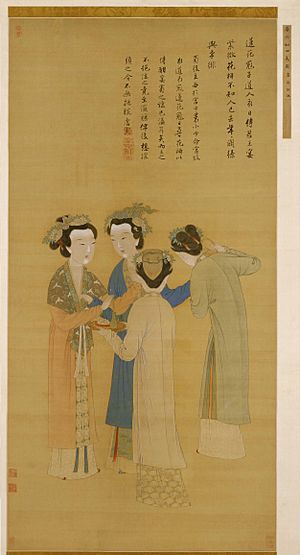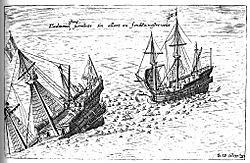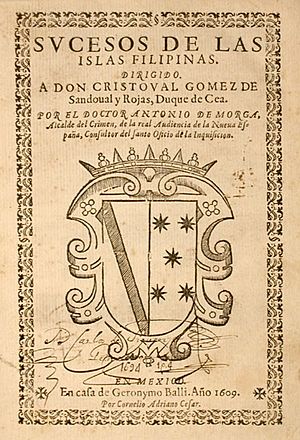Antonio de Morga facts for kids
Quick facts for kids
Antonio de Morga
|
|
|---|---|
 |
|
| Born | Antonio de Morga Sánchez Garay 29 November 1559 Seville, Spain |
| Died | 21 July 1636 (aged 76) Quito, Ecuador |
| Occupation | Colonial official, lawyer and writer |
| Language | Spanish |
| Citizenship | Spanish |
| Alma mater | University of Osuna University of Salamanca |
Antonio de Morga Sánchez Garay (born November 29, 1559 – died July 21, 1636) was an important Spanish official, lawyer, and writer. He worked for the Spanish government for over 40 years in places like the Philippines, New Spain (which is now Mexico), and Peru.
He was also a historian. After moving to Mexico, he wrote a famous book called Sucesos de las Islas Filipinas in 1609. This book is considered one of the most important works about the early days of Spanish rule in the Philippines. While he was a top official in the Philippines, he helped bring back a high court called the audencia. He also became a judge, known as an oidor. In 1600, he led Spanish ships in a sea battle against Dutch pirates, but his side lost, and he barely survived.
His book was first translated into English in 1868 and has been published many times since then. You can even find an English version online from 1907. It has also been printed in Spanish and other languages.
Contents
Early Life and Work in the Philippines
Antonio de Morga was born in Seville, Spain. He studied at the University of Salamanca and became a lawyer in 1580. Before going to the Philippines, he held several government jobs in Spain. In 1582, he got married to Juana de Briviesca de Munotones.
In 1593, he was chosen to be a top official in the Philippines. He traveled with his family, servants, and a large collection of books. His journey started in Spain in February 1594, and he arrived in Mexico in May. In Mexico, he helped prepare two ships for the trip across the Pacific Ocean and recruited 200 soldiers for the Spanish base in Manila. They left Mexico in March 1595 and reached Manila in June 1595. He held the second most powerful position in the colony.
Morga worked under different governors in the Philippines. He noticed that many Spanish soldiers faced tough conditions because they were young, didn't get paid much, and found the new environment difficult. Few people wanted to stay in Manila for long. His early reports to the Spanish King covered many topics, including Japan, Mindanao, and China, as well as daily life in the colony.
He made new rules to improve how the government worked. One of his important changes was bringing back the audencia, which was a high court. In 1598, he became a judge, or oidor, in this newly re-established court in Manila. This job meant he had to step back from some public duties.

During his time in Manila, Morga supported the important trade between Spain and China, known as the galleon trade. Chinese ships would come to Manila to trade their goods. From there, large Spanish ships called galleons would sail to Acapulco in Mexico. The goods were then sent to Mexico City and finally to Veracruz, where they were shipped to Spain. The Spanish paid for these goods with silver from Mexico, which became a common currency in China.
Morga wrote about many of the items imported from Ming dynasty China. He mentioned things like:
- Raw silk and fine silk of all colors.
- Beautiful velvets, some plain and some embroidered with gold.
- Woven fabrics and brocades made of gold and silver on silk.
- Damasks, satins, and taffetas.
He also listed other goods traded on the galleons, such as:
- Musk, benzoin, and ivory.
- Many bed ornaments, hangings, and tapestries.
- Tablecloths, cushions, and carpets.
- Horse gear embroidered with glass beads and small pearls.
- Pearls, rubies, sapphires, and crystals.
- Metal basins, copper kettles, and iron pots.
- Wheat flour and preserves made from fruits like orange, peach, and ginger.
- Salt pork and other salted meats.
- Live chickens and fine capons.
- Chestnuts and walnuts.
- Small boxes and writing cases.
- Beds, tables, chairs, and gilded benches.
- Domestic buffaloes, geese, horses, mules, and donkeys.
- Even caged birds that could talk or sing.
- Pepper and other spices.
Morga ended his list by saying there were so many "rarities" that he would never finish describing them all.
Sea Battle with Dutch Pirates
In 1600, Dutch pirates led by Olivier van Noort were attacking ships near Manila harbor. Governor Francisco de Tello de Guzmán and the high court asked Morga to gather ships and prepare a fleet to fight the Dutch. The available ships were the San Diego, the San Bartolomé, and some smaller ones. The San Diego and San Bartolomé were cargo ships, so they needed to be refitted for battle. Morga said this was done without using money from the government treasury, possibly with his own funds.
Morga had some military experience, having been a general of a Spanish fleet before, but he had never been in a real battle.
On December 1, 1600, Governor Tello made Morga the captain general of the fleet, ordering him to attack the two Dutch ships. The two sides met on December 14, 1600. The Spanish also had two ships. One Spanish ship chased after one of the Dutch ships. Morga's ship, the San Diego, was overloaded and its cannons were too low to fire. So, Morga ordered the San Diego to ram the Dutch ship Mauritius.
About 30 soldiers and some sailors from the San Diego boarded the Mauritius, taking control of parts of the ship and capturing the Dutch flag. The Dutch sailors retreated, and it looked like they might surrender. However, they soon started fighting again with guns and cannons.
A fierce, six-hour hand-to-hand battle followed, and many people were killed on both sides. The Mauritius caught fire. Fearing the fire, the San Diego pulled away. But the Spanish ship was sinking, either from the ramming or from the Dutch cannons.
The Dutch managed to put out the fire and sail away with their remaining sail and a small crew. They eventually reached Borneo. The other Dutch ship, however, was captured by the San Bartolome. It was taken to Manila, where its captain and 25 surviving sailors were executed.
The San Diego sank very quickly, and about 350 men were lost. Morga swam for four hours, holding onto the Dutch flag, and reached a small deserted island. A few other survivors from the ship also made it to the island.
This story comes from Morga's own book, Sucesos de las Islas Filipinas. He blamed the captain of the San Bartolome for the loss of the San Diego, saying he should have attacked the Mauritius instead of chasing the other Dutch ship. The Dutch had a very different story, saying Morga was not a good leader and was cowardly.
In 1992, French explorers found the sunken San Diego and its treasures. They found over 34,000 items, which was a huge archaeological discovery. These items included Chinese porcelain, Japanese swords, Spanish helmets, Portuguese cannons, and Mexican coins. A museum has been built on Fortune Island, where Morga and the other survivors landed, to show these artifacts.
Life in New Spain and Peru
On July 10, 1603, Morga was sent to Mexico (New Spain). He became a judge for criminal cases in Mexico City's Royal Court. He also advised the viceroy (the king's representative) on military matters. He worked in Mexico until 1615. During this time, in 1609, he published his famous history book about the Philippines.
In 1615, he was made president of the high court in Quito, which was part of the Viceroyalty of Peru. He arrived in Guayaquil on September 8, 1615, after almost being captured by Dutch pirates. He started his job in Quito on September 30, 1615. During his time there, the textile industry grew, and the University of San Gregorio Magno was founded. He also worked to improve how native peoples were treated.
Morga held the position of president of the Quito court for 20 years, from 1615 until his death in 1636. Most presidents of this court only served for about 5 years. He died in 1636.
His Famous Book: History of the Philippine Islands
While Antonio de Morga faced challenges in his military and government roles, his work as a historian was very successful. In 1609, he published the book he is most remembered for: Sucesos de las Islas Filipinas (which means Events in the Philippine Isles). This book is perhaps the best account of Spanish rule in the Philippines written during that time. It was based on his research of documents, his careful observations, and his own experiences.
The history book was published in two parts in 1609 in Mexico City. The viceroy of New Spain, Luis de Velasco, allowed its publication. The book covers the years from 1493 to 1603. It talks about the political, social, and economic life of both the native people and their Spanish rulers. Because Morga held an official position, he had access to many government documents, which helped him write his detailed history.
The book greatly impressed José Rizal (1861–96), a hero of Philippine independence. Rizal decided to add his own notes to the book and publish a new edition. He started this work in London and finished it in Paris in 1890. Rizal wrote:
If the book (Sucesos de las Islas Filipinas) succeeds to awaken your consciousness of our past, already effaced from your memory, and to rectify what has been falsified and slandered, then I have not worked in vain, and with this as a basis, however small it may be, we shall be able to study the future.
The first English translation of the book was published in London in 1868. Another English translation by Blair and Robertson was published in Cleveland in 1907 (and is available online). An edition edited by J.S. Cummins was published by the Hakluyt Society in 1971.
Images for kids
See also
 In Spanish: Antonio de Morga Sánchez Garay para niños
In Spanish: Antonio de Morga Sánchez Garay para niños







